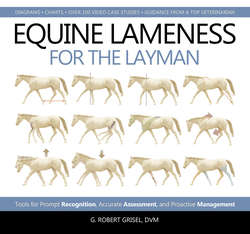Читать книгу Equine Lameness for the Layman - G. Robert Grisel DVM - Страница 5
На сайте Литреса книга снята с продажи.
Contents
ОглавлениеAcknowledgments
Introduction
Glossary
SECTION I
Our Responsibility to the Performance Horse
1 The Responsibility of the Horse Owner in Successful Management of Equine Lameness
2 The Responsibility of the Veterinarian in Successful Management of Equine Lameness
SECTION II
What Is Lameness?
3 The Definition of Lameness
4 The Art of Seeing Lameness
5 Obscure (Hidden) Lameness
Bilateral Lameness
Multifactorial Lameness
Axial Lameness
6 The Issue of Visual Subjectivity Among Observers
SECTION III
Forms of Lameness
Reference Chart: Common Forms of Lameness
7 Primary versus Secondary Lameness
Common Forms of Secondary Lameness
8 Painful versus Non-Painful Lameness
9 Weight-Bearing versus Non Weight-Bearing Lameness
10 Authentic versus Artificial Lameness
The Concept of Diagonal Synchrony
11 Axial versus Peripheral Lameness
The Head and Neck
12 Consistent versus Intermittent Lameness
Reference Chart: Intrinsic Causes of Tripping in the Horse
Reference Chart: List of Equine Skeletal Myopathies
Neurologic Lameness
Shifting Lameness
Reference Chart: Visual Markers for Neurologic Disease in the Horse
Rein Lameness
Behavioral Lameness
Reference Chart: Common Causes of Poor Behavior in the Symmetrically Moving Horse
13 Unique Lameness
Reference Chart: Classification of Unique Gait Deficits
SECTION IV
Pertinent Equine Anatomy
14 Terminology Relating to the Horse’s Movement
Reference Chart: Basic Classification of Equine Joints
Movement of the Limb and Foot
Movement of the Axial Anatomy
15 The Relationship Between Anatomy and Expression of Gait
Reference Chart: The Correlation Between Anatomic Function and the Nature of Associated Lameness
16 The Stay-Apparatus
The Stay-Apparatus of the Hind Limb
Reference Chart: Extrinsic Influences on the Behavior of the Hind Stay-Apparatus
Reference Chart: Classic Symptoms Associated with Mild Interference of the Hind Stay-Apparatus
The Stay-Apparatus of the Forelimb
17 Anatomic Behavior of the Lower Limb
The Flexor Apparatus
The Check Apparatus
The Suspensory Apparatus
Breakover
18 Basic Axial Anatomy
Axial Bones
Axial Joints
Axial Muscles
Axial Ligaments
19 Altered Muscle Anatomy and Function
Reference Chart: Intrinsic (Muscular) Causes for Biomechanical Lameness
Fibrotic Myopathy
SECTION V
The Fundamentals of Productive Observation
20 The Game Plan
Choosing the Approach
Choosing the Gait
Choosing the Venue
Reference Chart: Setting for Basic Visual Lameness Assessment
21 Rules of Effective Lameness Assessment
Basic Rules of Observation
22 Key Visible Elements of the Equine Gait
Asymmetry in Axial Movement
Asymmetry in the Quality of Stride
Asymmetry in Limb Gesturing
Asymmetry in Foot Dynamics
SECTION VI
The Method of Visual Lameness Assessment
Reference Chart: Basic Lameness Evaluation Protocol
23 Identifying the Affected Areas
Identifying the Lame Limb(s)
Detecting Forelimb Lameness
Detecting Hind-Limb Lameness
Detecting Axial Lameness
Detecting Complicated Lameness
Breed Considerations
Reference Chart: Basic Gaits of the Horse
24 Determining the Nature of Lameness
Weight-Bearing Lameness
Non Weight-Bearing Lameness
Combination Lameness
Highlighting the Nature of Lameness During Assessment
25 Determining the Severity (Degree) of Lameness
Standardized Grading of Lameness
Reference Chart: American Association of Equine Practitioners (AAEP) Grading Scale
26 Determining Extrinsic Influences on Lameness
Temporal and Thermic Variations
Footing
Direction
Gradient
Gait
Velocity
Form of Restraint
Reference Chart: Extrinsic Influences on the Nature of Lameness
27 Identifying Distinctive Features of the Gait
Suggestive Traits
Reference Chart: Lameness Traits That Are Suggestive
Symptomatic Traits
Reference Chart: Lameness Traits That Are Symptomatic
Pathognomonic Traits
Reference Chart: Lameness Traits That Are Pathognomonic
28 Confirming the Primary Component(s) of Lameness
Manifestations of Referred Lameness
Reference Chart: Step-by-Step Lameness Assessment of the Horse
SECTION VII
The Gait Signature
29 Designation of the Horse’s Gait Signature
Reference Chart: Sample Classification of Gait Characteristics
30 Correlating the Gait Signature with Likely Sources of Lameness
Reference Chart: Sample Correlation of Gait Deficits with Veterinary Diagnoses
SECTION VIII
Applying Our Observations to the Diagnostic Process
31 Visual Observation as Part of the Diagnostic Workup
32 Building and Sharing Your Gait Signature Library
Video Archiving
Written Reports
Include the Diagnosis
Sharing Records
33 The Future of Visual Assessment and Gait Signature Characterization in the Diagnosis and Management of Equine Lameness
References
Video Quick Reference Library
About the Author
Index
